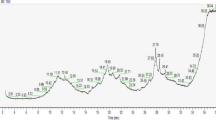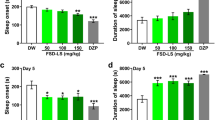Abstract
Objective
To assess the biological effects of the six-herb mixture Anti-Insomia Formula (AIF) extract using caffeine-induced insomnia Drosophila model and short-sleep mutants.
Methods
Caffeineinduced insomnia wild-type Drosophila and short-sleep mutant flies minisleep (mns) and HyperkineticY (HkY) were used to assess the hypnotic effects of the AIF in vivo. The night time activity, the amount of night time sleep and the number of sleep bouts were determined using Drosophila activity monitoring system. Sleep was defined as any period of uninterrupted behavioral immobility (0 count per minute) lasting > 5 min. Night time sleep was calculated by summing up the sleep time in the dark period. Number of sleep bouts was calculated by counting the number of sleep episodes in the dark period.
Results
AIF at the dosage of 50 mg/mL, effectively attenuated caffeine-induced wakefulness (P<0.01) in wild-type Canton-S flies as indicated by the reduction of the sleep bouts, night time activities and increase of the amount of night time sleep. AIF also significantly reduced sleeping time of short-sleep HkY mutant flies (P<0.01). However, AIF did not produce similar effect in mns mutants.
Conclusion
AIF might be able to rescue the abnormal condition caused by mutated modulatory subunit of the tetrameric potassium channel, but not rescuing the abnormal nerve firing caused by Shaker gene mutation. This study provides the scientific evidence to support the use of AIF in Chinese medicine for promoting sleep quality in insomnia.
Similar content being viewed by others
References
Li RH, Wing YK, Ho SC, Fong SY. Gender differences in insomnia—A study in the Hong Kong Chinese population. J Psychosom Res 2002;53:601–609.
Zhang J, Lam SP, Li SX, Li AM, Lai KY, Wing YK. Longitudinal course and outcome of chronic insomnia in Hong Kong Chinese children: a 5-year follow-up study of a community-based cohort. Sleep 2011;34:1395–1402.
Mahowald MW, Schenck CH. Insights from studying human sleep disorders. Nature 2005;437:1279–1285.
National Institutes of Health. National Institutes of Health State of the Science Conference Statement on Manifestations and Management of Chronic Insomnia in Adults. Sleep 2005;28:1049-1057.
Zhang J, Li AM, Kong AP, Lai KY, Tang NL, Wing YK. A community-based study of insomnia in Hong Kong Chinese children: prevalence, risk factors and familial aggregation. Sleep Med 2009;10:1040–1046.
Roth T. Insomnia: definition, prevalence, etiology, and consequences. J Clin Sleep Med 2007;3(5 Suppl):S7–S10.
Sateia MJ, Doghramji K, Hauri PJ, Morin CM. Evaluation of chronic insomnia. An American Academy of Sleep Medicine review. Sleep 2000;23:243–308.
Morin CM, Gramling SE. Sleep patterns and aging: comparison of older adults with and without insomnia complaints. Psychol Aging 1989;4:290–294.
Bonnet MH, Arand DL. Hyperarousal and insomnia: state of the science. Sleep Med Rev 2010;14:9–15.
Erman MK. Therapeutic options in the treatment of insomnia. J Clin Psychiatry 2005;66(Suppl)9:18–23.
Lam SP, Fong SY, Ho CK, Yu MW, Wing YK. Parasomnia among psychiatric outpatients: a clinical, epidemiologic, cross-sectional study. J Clin Psychiatry 2008;9:1374–1382.
Wing YK. Herbal treatment of insomnia. Hong Kong Med J 2001;7:392–402.
Flaws R, ed. Curing insomnia naturally with Chinese medicine. 1st ed. Boulder, Colorado, SA: Blue Poppy Press; 1997:67–80.
Chinese Pharmacopoeia Commission. Pharmacopoeia of the People's Republic of China. Beijing: People's Medical Publishing House; 2010.
Huber R, Hill SL, Holladay C, Biesiadecki M, Tononi G, Cirelli C. Sleep homeostasis in Drosophila melanogaster. Sleep 2004;27:628–639.
Shaw PJ, Cirelli C, Greenspan RJ, Tononi G. Correlates of sleep and waking in Drosophila melanogaster. Science 2000;287:1834–1837.
Kawahara M, Kagiyama H, Kanazawa Y, Tsuchiya H, Tomita K, Yokogawa K, et al. Rapid determination method of caffeine and application to monitoring of caffeine-assisted chemotherapy. Biopharm Drug Dispos 2004;25:61–67.
Cirelli C, Bushey D, Hill S, Huber R, Kreber R, Ganetzky B, et al. Reduced sleep in Drosophila Shaker mutants. Nature 2005;434:1087–1092.
Bushey D, Huber R, Tononi G, Cirelli C. Drosophila hyperkinetic mutants have reduced sleep and impaired memory. J Neurosci 2007;27:5384–5393.
Hendricks JC, Finn SM, Panckeri KA, Chavkin J, Williams JA, Sehgal A, et al. Rest in Drosophila is a sleep-like state. Neuron 2000;25:129–138.
Cirelli C. The genetic and molecular regulation of sleep: from fruit flies to humans. Nat Rev Neurosci 2009;10:549–560.
Manev H, Dimitrijevic N, Dzitoyeva S. Techniques: fruit flies as models for neuropharmacological research. Trends Pharmacol Sci 2003;24:41–43.
Stern M, Ganetzky B. Altered synaptic transmission in Drosophila hyperkinetic mutants. J Neurogenet 1989;5:215–228.
Josephs KA, Silber MH, Fealey RD, Nippoldt TB, Auger RG, Vernino S. Neurophysiologic studies in Morvan syndrome. J Clin Neurophysiol 2004;21:440–445.
Chouinard SW, Wilson GF, Schlimgen AK, Ganetzky B. A potassium channel beta subunit related to the aldo-keto reductase superfamily is encoded by the Drosophila hyperkinetic locus. Proc Natl Acad Sci U S A 1995;92:6763–6767.
Ueda A, Wu CF. Effects of hyperkinetic, a beta subunit of Shaker voltage-dependent K+ channels, on the oxidation state of presynaptic nerve terminals. J Neurogenet 2008;22:1–13.
Paterson LM, Wilson SJ, Nutt DJ, Hutson PH, Ivarsson M. Characterisation of the effects of caffeine on sleep in the rat: a potential model of sleep disruption. J Psychopharmacol 2009;23:475–486.
Author information
Authors and Affiliations
Corresponding author
Additional information
Supported by Research Fund for Innovation and Technology Support Programme (No. GHP/037/05), Innovation and Technology Commission, Hong Kong SAR, China
These authors contributed equally to this work
Rights and permissions
About this article
Cite this article
Ko, Ch., Koon, Cm., Yu, Sl. et al. Hypnotic effects of a novel anti-insomnia formula on Drosophila insomnia model. Chin. J. Integr. Med. 22, 335–343 (2016). https://doi.org/10.1007/s11655-014-1625-1
Received:
Published:
Issue Date:
DOI: https://doi.org/10.1007/s11655-014-1625-1




